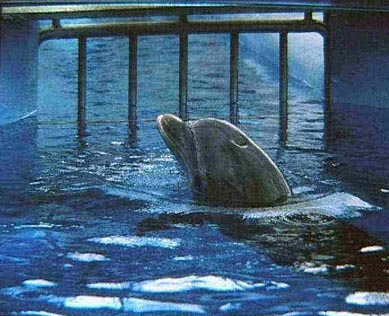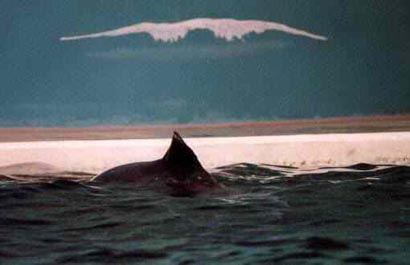

Pam's Note: I will keep this page updated with the latest news of Iris as I receive them from Yvon. Yvon has dedicated his life in saving Iris, as well as thousands of other concerned people! Please give him all the support you can! MANY THANKS!

Iris was one of the thousand bottlenose dolphins living in captivity, but
because of her zeal for living, her will to defend her son in the hell of
the Antwerp Zoo and finally of her refusal to participate in all the shows,
she has become the symbol and perhaps even the hero of the mad captivity and
destructive industry.
Instead of letting her die in this scandalous way it would have been very
simple to bring her to a retirement lagoon. She would have quickly found
enough reasons to live and to become healthy again. and perhaps even to be
free again. Nothing has been gained. Iris was killed. Thousands of others
await the same fate, we know today that not a single captive dolphin leaves
its captivity alive.
The responsabilities are heavy in the death of Iris.
For the management of Duisburg :
Mainly for economic reasons, Iris was left to her fate. She could have been
taken to a beach lagoon such as Conyland or the dolphinarium in Harderwijck
where she could have lived under better circumstances but this was not an
option because of budgetary reasons. Iris was only 33 years of age.
Even in captivity she could easily have lived another 20 years on condition
that she would live in decent living circumstances. Proof is that, although
exceptional, Nelly in Marineland (Florida) reached the age of 50.
The German press did not even report the death of Iris. Not even the website
of the zoo, apparently she is still alive.
Worst still. in February 2003 we received a message from our correspondent
advising us that rumours were circulating that the trainers of the Duisburg
Zoo were preparing for Easter "something will be done for Iris". More he did
not know what. In our naïvety we believed in a positive change but this was
not so. Probably the euthanasia was being prepared.
For the management of the Antwerp Zoo :
In 1997 and 1998 we repeatedly notified the Antwerp Zoo of the dangers
involved in transporting their last dolphins to Germany.
At that time successfull rehabilitation plans were being applied. There are
many examples. They were refused and, this is the climax, because for the
safety of the dolphins. Once the dolphins arrived none of the Antwerp
trainers who were so attached to the animals found it worthwhile to help
their "dolphins". In 1999 the press assured us that the situation was
absolutely "normal", regardless of the constant fighting between the two
dominant male dolphins and the deep depression of Iris. Her last pregnancy
resulted in a dead calf and was a clear sign of her depression.
For activists :
We are still waiting for plans and common consultations to build a "retreat
and rehabilitation lagoon" in a confined bay where captive dolphins could
sojourn to gain strength prior to being returned to their native habitats.
These last years different suggestions have been made but no unanimous
decisions were reached. It is, however the only acceptable solution for most
of the "old" dolphins such as Iris, kept in captivity in Europe.
Finally, we would like to add that, according to Rick O'Barry, depressions
are very frequent and almost unavoidable after several years of captivity.
But of course, this syndrome is kept hidden by the pleasure industry.
Euthanasia is often used on old dolphins as on other animals in captivity
that are no longer showable to the public and thus only costs money. This is
a universal economic law which holds true for every zoo and every circus in
the world.
Shocked ?
Not really, if we see the example of European laws that all none human
animals have no conscience and that we are free to deal with them as "real
estate"....even if they are endowed with memory, cultures, languages and
moral intelligence such as dolphins.
Please send your reactions to the Zoo of Duisburg. Please visit YVON'S WEBSITE for the contacts you will need.
Thank you.
In the dark cold Duisburg Zoo's aquarium, Iris and Ivo, the two former
last Antwerp's dolphins, are still alive. They recently had to cope with important significant health problems. Both
of them seem to have get a cold during this winter but it's OK now.
On the other hand, Ivo is still obliged to swallow by force four litres of fresh water each days, two times a day. Dolphins are not supposed to drink but we know that Ivo is suffering a serious kidneys' problem since Antwerp Zoo's time.
Iris receives also special care but for other reasons. Each day, twice per day, trainers smear her dorsal fin and her back with
Vaseline, undoubtedly because Iris did not plunge any more for a much too long time.
Permanently floating at the surface of her little basin as a dead log, she exposes the top of her body to the fresh air, so her skin is desiccating, exactly like the skin of a stranded dolphin.
She doesn't move. But she lives.
At the age of 33 (34 ? ), she doesn't give up. Is it a good thing for her in such life conditions? Maybe. As for Keiko, let's respect the decisions of Iris who is an intelligent and autonomous marine mammal. Perhaps it is the presence of the funny small Duke who brings some light to Iris, maybe is it her attachment to her son Ivo ...
Who knows ? Any how, Iris seems to have decided to stay alive as long as possible and as if it is her choice, we must respect it.
The four other dolphins are well. Among them, Little Duke, the captive-born son of Pepina and Ivo, who is
now sixteen months old. He is already sexually teasing the females, as do all the small calves in the seas. Of course, there is a difference. His playmates will be always the same ones, his mother, his sisters, his old grandma who never moves out of her water hole and the huge terrifying dominating male Ivo. One day, of course, if he ever survives, Duke will have to leave this place for another facility, where he will be separated forever from his mother and family forever. If he ever survives...
Yvon
For the full story visit Yvon's website.

English files and complete story on:
http://www.dauphinlibre.be/iris2.htm
More files in French on:
http://www.dauphinlibre.be.iris.htm
The history of the "two Antwerp's dolphins" is quite ordinary : captured in 1981 in the Gulf of Mexico with some other members of their family, Iris and Ivo survived 18 years in the criminally narrow basin of the Delphinarium of Antwerp Zoo.
At the time they were caught, Iris was living free since a dozen years in the ocean. Ivo, her son, was only one or two years old and it's a real miracle he was able to survive the very first years of his detention.
It's indeed important to know that ALL the jail companions of Iris and Ivo ended dying one after one after interminable anguishes. Dolly and Illas - the faithful companion of iris, undoubtedly coming from the original same pod - were the last "dolphin founders " to die near them around 1995-1996.
And then, one day, Iris and Ivo found themselves all alone in the middle of the cemetery-pool of Antwerp...
http://www.dauphinlibre.be/irisivo4.htm
http://www.dauphinlibre.be/irisivo5.htm
Boredom started to slowly undermine them : they were briefly associated with some sealions during the shows, they perform some " dolphin therapy treatment" for autistic children or blind ones, but in vain: confined in this highly chlorinated water which burned them the eyes, Iris and Ivo did not feel well and became weaker day after day...
The Antwerp Zoo opinion was to let them die there. Just wait, they said. The problem will be resolved before long. That was the rule in Antwerp : dolphins perform until they are unable to do so because of weariness and boredom.
Then, as for Dolly and in principle, as for Iris, Zoo carries out euthanasia, declaring publicly that the dolphin died of old age. Sometimes, of some dolphins survived longer than others. They were shown as a proof that captivity provides good living conditions, even though it's more a proof of desperate adaptability !
A vigorous but difficult campaign, gathering many national and international associations happily, prevent this fatal ending. Antwerp's Zoo finally decided, during spring 1999, to send the two ultimate survivors towards Duisburg Delphinarium.
Although more than 40 dolphins and other captive cetaceans already died in this small German zoo, Play Boy and its small troop of females lived there, still peacefully, in a large and ozone-cleaned basin. Following the " experts" opinion ,all linked to Zoos, this transfer would be a good thing for our "Belgian dolphins ".
Some years later, in 2002, this " usefull integration in a new social group" shows its terrible results :
http://www.dauphinlibre.be/duisb2.htm
http://www.dauphinlibre.be/fresh.htm
http://www.dauphinlibre.be/duisjune001.htm
Beyond this individual story of the two "Belgian dolphins", a larger and more alarming problem appears : what about the so-called "old dolphins", exhausted by years and years of public shows and captivity? Which future for them?
We must clearly realize that the situation of Iris will be exactly the same for ALL the 3,000 captive dolphins or more surviving in the world : they will all die in the pool where they've lived years long without any hope of rest or freedom. And they will be immediately replaced by "fresher" and younger ones...
If some old elephants, old chimpanzees and other circus-animals, exhausted from shows, are entitled - as in the USA - to real "centers of retirement", where they can complete their "artist-life" in dignity and under relatively decent conditions, why is this not the case for dolphins?
If only in the name of our own moral values, there is urgency to tackle this painful chapter of the "old circus-animals ".
The veterinaries know, just like all of us, that after a certain number of years, the "burn-out"-syndrome catches up with all of them. It is a crime to let them die under those conditions, as is currently the case.
Although, to organize an individual rehabilitation process for each dolphin, to rent a new sea-pen each time is a very expensive and exceptional process. Until now, that's the only way dolphins were rehabilitated.
Various proposals were made to create well equiped permanent centers, either in Port saint Père or on the l'île des Embiez, or, as suggested several times by Ric O' Barry, somewhere in Spain or in the Caribbean.
Why? It seems as if the delphinarium-lobby is even more powerful than suspected.
Creating such "retirement lagoons", we could also answer to other needs :
Very concrete plans exist but no follow-on actions were ever taken.
http://www.dauphinlibre.be/cerman.htm
As far as the project of the Island of Embiez is concerned, human visits would have been prohibited, the dolphins were to remain with their own in the lagoon and could be observed only from watchtowers. In addition to the financial and tourist impact of this possibility of dolphin-watching, the dolphins of the lagoon would have gradually been weaned off human contacts and by that be prepared for a gentle and gradual return to sea.

It is actually necessary to take into consideration that if one day, the delphinariums suddenly closed, these protected facilities could be used for all captive dolphins who either have spent a lot of their life-time in basins or were even born there. After all, these animals have become seriously dependent on human care and could not regain the oceans without careful preparation.
Of course, many of the recently captured dolphins could certainly quickly re-adapt to freedom but it is obvious that the damages caused by a long lasting containment are so far reaching that the rehabilitation of " old dolphins " proves always extremely difficult.
But that does not mean to confirm the assumption that these rehabilitations always turn into failures !
Scientists know pertinently well that an intelligent animal capable of surviving a captivity under intolerable conditions is also clever enough to re-learn the routines of a natural life.
Well prepared actions are always successful; a prove is the latest rehabilitation of the dolphins Ariel and Turbo, led by the WSPA.
Also the impressive list of all the successful rehabilitations, as reported by Kenneth C Balcomb III, is to be taken into consideration.
If anti-captivity campaign's only result is a transfer to another facility, activists are clearly making more harm than good to the dolphins.
To know more about dolphin rehab' and
retirement centers for old captive animals.
http://www.rockisland.com/~orcasurv/releases.htm
http://www.wspa-americas.org/dolphins-html/dolphins_wspa_history.htm
http://www.wspa.ca/dolphins/guatemala.html
http://www.thewest.com.au/20011207/features/tw-features-home-sto31832.html